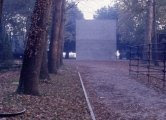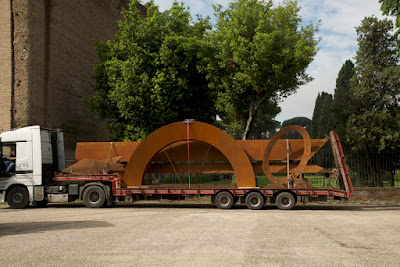 |
Mauro Staccioli's "Portale," 2014. An opening,
rather than a closing off. Compare with Staccioli's contribution to the 1978 Biennale, below. |
The Baths of Caracalla are always impressive--a Rome-the-First-Time experience, to be sure. But for the next ten days or so the Baths are a special treat. Through September 30, this monumental complex is the site an equally monumental set of sculptures by Italian artist Mauro Staccioli. Titled "Sensibile ambientale" (environmental sensibility), the show is the first retrospective of the work of Staccioli, who died at age 80 on January 1, 2018.
Curated by Alberto Fiz, the exhibition features 26 pieces, some outside, above ground, and some inside, along the underground passages of the Baths.

Tuscan by birth, Staccioli received his arts education at the Art Institute in Volterra, taught in Cagliari (Sardinia) for some years after 1960, before joining the Academy of Fine Arts of Brera in Milan in 1968.

Invited to exhibit at the Venice Biennale in 1978, he fashioned the wall that made him famous, even notorious: a 26-foot concrete barrier, provocatively obstructing the view of the Italian pavilion.
Working in a minimalist vein, Staccioli favored basic geometric forms but on a grand scale. His passion was the relationship of a work of art to its environment. Writing in
Art Forum in 1995, critic Giorgio Verzotti wrote, " In his indoor as well as in his outdoor installations, Mauro Staccioli's sculptures set up a tension between the work itself and the exhibition site."
In selecting the Baths for the retrospective (we assume he was involved in that process before his death), Staccioli took on an unusual challenge. Although many of his sculptures are huge and inherently imposing--not unlike the iron behemoths of Richard Serra--the Baths are monumental on a scale all their own.
In some cases, then, the "tension" between the work and the site is a tension between monumentalisms--the Baths on the one hand, Staccioli's sculptures on the other. In some cases, though certainly not all, the Baths swallow, absorb, and minimize Staccioli's work, as in the photo below.
 |
| Here, Staccioli's ring sculpture is dominated by the Baths |
In others--perhaps especially the interior pieces--the sculptor's creations hold their own, dominate, or (see below) simply enhance the look and feel of the Baths. Dianne at right.
Although Staccioli did not live to see the exhibition installed, we like to think he would have enjoyed all the complex ways in which his work interacts with one of the most dramatic sites in Rome.
Visitors may (assuming it's still there) also enjoy Michelangelo Pistoletto's nicely lit "The Replenished Apple," which resides in one of the underground chambers.
 |
| Pistoletto's "The Replenished Apple" |
Staccioli has permanent installations at a dozen or more locations around the world, including the Olympic Park in Seoul, the Parc Tournay-Solvay in Brussels, and Villa Glori in Rome. Whether permanent or not, a powerful and elegant Staccioli piece fronts the Galleria Nazionale d'Arte Moderna, on via Belle Arti (below).
The Staccioli exhibit at the Baths of Carcalla closes September 30, 2018. Bill
 |
| Staccioli's magnificent addition to the Galleria Nazionale d'Arte Moderna |







